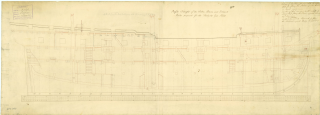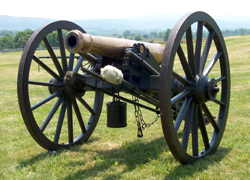Related Research Articles

A carronade is a short, smoothbore, cast-iron cannon which was used by the Royal Navy. It was first produced by the Carron Company, an ironworks in Falkirk, Scotland, and was used from the 1770s to the 1850s. Its main function was to serve as a powerful, short-range, anti-ship and anti-crew weapon. The technology behind the carronade was greater dimensional precision, with the shot fitting more closely in the barrel thus transmitting more of the propellant charge's energy to the projectile, allowing a lighter gun using less gunpowder to be effective. Carronades were initially found to be very successful, but they eventually disappeared as naval artillery advanced, with the introduction of rifling and consequent change in the shape of the projectile, exploding shells replacing solid shot, and naval engagements being fought at longer ranges.

Sovereign of the Seas was a 17th-century warship of the English Navy. She was ordered as a 90-gun first-rate ship of the line of the English Royal Navy, but at launch was armed with 102 bronze guns at the insistence of the king. It was later renamed HMS Sovereign, and then HMS Royal Sovereign at the Restoration of Charles II.

The Tsar Cannon is a large early modern period artillery piece on display on the grounds of the Moscow Kremlin. It is a monument of Russian artillery casting art, cast in bronze in 1586 in Moscow, by the Russian master bronze caster Andrey Chokhov. Mostly of symbolic impact, it was never used in a war. However, the cannon bears traces of at least one firing. Per the Guinness Book of Records it is the largest bombard by caliber in the world, and it is a major tourist attraction in the ensemble of the Moscow Kremlin.

The Warrior-class ironclads were a class of two warships built for the Royal Navy between 1859 and 1862, the first ocean-going ironclads with iron hulls ever constructed. The ships were designed as armoured frigates in response to an invasion scare sparked by the launch of the French ironclad Gloire and her three sisters in 1858. They were initially armed with a mix of rifled breech-loading and muzzle-loading smoothbore guns, but the Armstrong breech-loading guns proved unreliable and were ultimately withdrawn from service.

HMS Black Prince was the third ship of that name to serve with the Royal Navy. She was the world's second ocean-going, iron-hulled, armoured warship, following her sister ship, HMS Warrior. For a brief period the two Warrior-class ironclads were the most powerful warships in the world, being virtually impregnable to the naval guns of the time. Rapid advances in naval technology left Black Prince and her sister obsolete within a short time, however, and she spent more time in reserve and training roles than in first-line service.

Turret ships were a 19th-century type of warship, the earliest to have their guns mounted in a revolving gun turret, instead of a broadside arrangement.

Horsmonden is a village in the borough of Tunbridge Wells in Kent, England. The village is located in the Weald of Kent. It is situated on a road leading from Maidstone to Lamberhurst, three miles north of the latter place. The nearest railway station is Paddock Wood.

Naval artillery is artillery mounted on a warship, originally used only for naval warfare, later also for shore bombardment and for anti-aircraft use. The term generally refers to tube-launched projectile-firing weapons and excludes self-propelled projectiles like torpedoes, rockets, and missiles and those simply dropped overboard like depth charges and naval mines.

HMS Defence was the lead ship of the Defence-class armoured frigates ordered by the Royal Navy in 1859. Upon completion in 1862 she was assigned to the Channel Fleet. The ship was paid off in 1866 to refit and be re-armed and was briefly reassigned to the Channel Fleet when she recommissioned in 1868. Defence had short tours on the North Atlantic and Mediterranean Stations, relieving other ironclads, from 1869 to 1872 before she was refitted again from 1872 to 1874. She became guard ship on the River Shannon when she recommissioned. The ship was transferred to the Channel Fleet again in 1876 and then became guard ship on the River Mersey until 1885. Defence was placed in reserve until 1890 when she was assigned to the mechanical training school in Devonport in 1890. She was renamed Indus when the school adopted that name and served there until sold for scrap in 1935.

HMS Achilles was an armoured frigate built for the Royal Navy in the 1860s. Upon her completion in 1864 she was assigned to the Channel Fleet. The ship was paid off in 1868 to refit and be re-armed. When she recommissioned in 1869, she was assigned as the guard ship of the Fleet Reserve in the Portland District until 1874. Achilles was refitted and re-armed again in 1874 and became the guard ship of the Liverpool District in 1875. Two years later, she was rejoined the Channel Fleet before going to the Mediterranean in 1878. The ship returned to the Channel Fleet in 1880 and served until she was paid off in 1885.

The River Teise is a tributary of the River Medway in Kent, England.
Swan was a 200-ton warship of the English navy, launched as a Royalist vessel in 1641 but captured by the Commonwealth of England when her crew revolted in 1645. She carried twelve cannons, which were cast by John Browne.
William Levett was an English clergyman. An Oxford-educated country rector, he was a pivotal figure in the use of the blast furnace to manufacture iron. With the patronage of the English Crown, furnaces in Sussex under Levett's ownership cast the first iron muzzle-loader cannons in England in 1543, a development which enabled England to ultimately reconfigure the global balance-of-power by becoming an ascendant naval force. William Levett continued to perform his ministerial duties while building an early munitions empire, and left the riches he accumulated to a wide variety of charities at his death.

Military forces of the Ottoman Empire used a variety of weapons throughout the centuries. The armoury in Topkapı Palace has a large collection of which it shows select items.

The 68-pounder cannon was an artillery piece designed and used by the British Armed Forces in the mid-19th century. The cannon was a smoothbore muzzle-loading gun manufactured in several weights, the most common being 95 long cwt (4,800 kg), and fired projectiles of 68 lb (31 kg). Colonel William Dundas designed the 112 cwt version in 1841 and it was cast the following year. The most common variant, weighing 95 cwt, dates from 1846. It entered service with the Royal Artillery and the Royal Navy and saw active service with both arms during the Crimean War. Over 2,000 were made and it gained a reputation as the finest smoothbore cannon ever made.

HMS Pallas was one of the three 36-gun Venus-class fifth-rate frigates of the Royal Navy. She was launched in 1757 and served until her loss in 1783.

HMS Brilliant was a 36-gun Venus-class fifth-rate frigate of the British Royal Navy that saw active service during the Seven Years' War with France. She performed well against the French Navy in the 1760 Battle of Bishops Court and the 1761 Battle of Cape Finisterre, but was less capable when deployed for bombardment duty off enemy ports. She also captured eight French privateers and sank two more during her six years at sea. The Royal Navy decommissioned Brilliant in 1763. The Navy sold her in 1776 and she became an East Indiaman for the British East India Company (EIC). Brilliant was wrecked in August 1782 on the Comoro Islands while transporting troops to India.

The M1841 6-pounder field gun was a bronze smoothbore muzzle-loading cannon that was adopted by the United States Army in 1841 and used from the Mexican–American War to the American Civil War. It fired a 6.1 lb (2.8 kg) round shot up to a distance of 1,523 yd (1,393 m) at 5° elevation. It could also fire canister shot and spherical case shot. The cannon proved very effective when employed by light artillery units during the Mexican–American War. The cannon was used during the early years of the American Civil War, but it was soon outclassed by newer field guns such as the 12-pounder Napoleon. In the US Army, the 6-pounders were replaced as soon as more modern weapons became available and none were manufactured after 1862. However, the Confederate States Army continued to use the cannon for a longer period because the lesser industrial capacity of the South could not produce newer guns as fast as the North.

The M1841 12-pounder howitzer was a bronze smoothbore muzzle-loading artillery piece that was adopted by the United States Army in 1841 and employed from the Mexican–American War to the American Civil War. It fired a 8.9 lb (4.0 kg) shell up to a distance of 1,072 yd (980 m) at 5° elevation. It could also fire canister shot and spherical case shot. The howitzer proved effective when employed by light artillery units during the Mexican–American War. The howitzer was used throughout the American Civil War, but it was outclassed by the 12-pounder Napoleon which combined the functions of both field gun and howitzer. In the US Army, the 12-pounder howitzers were replaced as soon as more modern weapons became available. Though none were manufactured after 1862, the weapon was not officially discarded by the US Army until 1868. The Confederate States of America also manufactured and employed the howitzer during the American Civil War. The Confederate armies used the outmoded howitzer for a longer period.

The 10-pounder Parrott rifle, Model 1861 was a cast iron muzzle-loading rifled cannon that was adopted by the United States Army in 1861 and often used in field artillery units during the American Civil War. Like other Parrott rifles, the gun breech was reinforced by a distinctive wrought iron reinforcing band. The gun fired a 9.5 lb (4.3 kg) projectile to a distance of 1,850 yd (1,692 m) at an elevation of 5°. The 10-pounder Parrott rifle was capable of firing shell, shrapnel shell, canister shot, or solid shot. Midway through the war, the Federal government discontinued the 2.9 in (74 mm) version in favor of a 3.0 in (76 mm) version. Despite the reinforcing band, the guns occasionally burst without warning, inflicting injury on the gun crews. The Confederate States of America manufactured a number of successful copies of the gun.
References
- 1 2 Kentish Fire, Chapter 6
- ↑ Cyber Diver News Network Archived 2008-07-05 at the Wayback Machine
- ↑ Goliath
- ↑ The Guardian
- ↑ Journal of the House of Commons (1642). [ permanent dead link ]
- ↑ Journal of the House of Commons (1645). [ permanent dead link ]
- ↑ Ferrers
- ↑ "KENT". Hammerpond. Retrieved 11 January 2010.